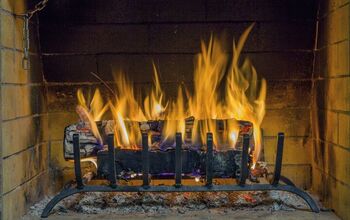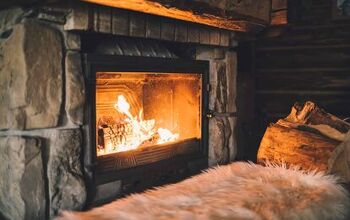What To Do With Fireplace Ashes

Building and maintaining a fire in your fireplace is a skill that doesn’t end when the flames go out. Once the fire has run its course and the coals have all cooled, the fire might be over, but your work is not yet done. The leftover ash must be cleaned out, removed, and disposed of. But as you sweep up all this gray and black powder, you may wonder what you can do with the ashes in your fireplace other than throwing them in the trash.
To give the ashes left in your fireplace a new life, add them to your compost pile or sprinkle them in your garden to ward off pests. You can use fireplace ashes as an ant deterrent or an odor remover. They can absorb moisture, so place some in damp areas to lower humidity. If you want to try a DIY project, make soap using ashes as a main ingredient.
Ashes at the bottom of your fireplace or fire pit look like a messy inconvenience at first glance. They aren’t fun or easy to clean up, but the good news is that there are all sorts of great ways you can use these ashes around the home and yard after you've swept them up. Below is a list of all the best creative and effective ways to use ashes leftover from a fire, as well as top tips to help make cleaning up ashes easy and safe.
10 Ways You Can Use Ashes Left Over From A Fire
1. Add Them To Your Compost
One great way to utilize the ashes from your fire is to add them to your compost. Ashes have high levels of carbon and other minerals, which add to the quality of your compost. Another great reason to add ashes to compost is that they are very alkaline.
Compost tends to have a high acidity due to the materials added to it and what happens to them as they decompose. The alkaline nature of ash helps neutralize this acidity, which makes the compost closer to the ideal pH to add to your soil. It can also improve the smell of your compost while balancing the pH.
2. Fold The Ashes Into Your Soil To Raise The pH
If you need to address an immediate issue with your soil’s pH, you can consider folding some ashes directly into your soil. If you live in an area with very acidic earth, then ash can work to quickly neutralize this issue.
Make sure you test the soil and only add ash very conservatively. You don’t want to add so much ash that your soil becomes too alkaline. Moderation is the best way to change your soil’s pH.
3. Make Homemade Soap
Ashes have a lot of practical uses, including turning them into a fun DIY project. You can make a lye solution using water and wood ash. This solution is a natural cleanser that can then be added to fat or oil to help make soap.
You can add natural oils and herbs from your garden to make a homegrown soap. This is a great way to give wood ash a new life, and it can make a great gift for your friends.
4. Sprinkle Ashes In Your Garden To Repel Pests
Ashes not only help your garden by neutralizing the pH, but you can also use it to repel several common garden pests. Ash is coarse and dry, so it is great at repelling small and wet pests.
Creatures like snails and slugs can dry out and get sliced by ash. Other common garden pests, including aphids and other insects, can also be turned off by ash. If you have a problem with any of these garden pests, consider sprinkling ash on all affected and nearby plants.
5. Use Ashes To Get Rid Of Ants
Ashes can be used outside the garden to ward off other pests. This powder can be particularly effective at eliminating ants in your home and garden. The composition of wood ash is not as soft as it appears to the naked eye.
Ashes are abrasive and can seriously damage the exoskeletons of certain insects, especially ants. Sprinkling ashes in a line in areas where these tiny pests have been seen is a great way to help get rid of ants.
6. Polish Your Metal
Ash may look dirty, but it is surprisingly effective at helping make some objects sparkle and look clean. Since ash contains certain tiny abrasive particles and minerals, it is a great scrub to remove tarnish from metal.
These particles, including calcium and magnesium, can help remove dust, layers of film and grime, and other tarnish from your silver, copper, and steel. Once you’ve cleaned your fireplace, consider continuing your cleaning spree by polishing up your metal appliances and fixtures.
7. Use It As Ice Melt
If you are looking for ways to make your walkways less slippery, wood ash is an effective option.
Ash has a very low freezing point, so when it is mixed with snow and water, it takes much colder temperatures for it to freeze. It can also melt ice that has formed on your walkways, just like salt and other ice melts do.
Sure, it might look a lot messier than salt, but ash is less harmful to your plants and lawn than salt and chemical ice melts.
8. Get Rid Of Bad Odors In Your Home
Ash acts like a sponge for odors. This is mostly thanks to the alkaline nature of wood ash. You can use it instead of baking soda in your refrigerator to remove bad smells, and also near litter boxes.
If you or a pet is sprayed by a skunk, it is effective at removing the skunk smell. Any acidic smell will be reduced if you have wood ash nearby.
9. Place Ashes In Damp Areas To Absorb Moisture
If you have a humidity problem in a specific area in your home, like a basement, then put a container of wood ash in the room. Just as ash can absorb smells, it can also absorb moisture. Place it in an open container in any musty area like a wet closet or recently flooded basement. It can help reduce the humidity and get rid of the musty smell at the same time.
Five Tips To Help Safely Remove Ashes From A Fire
1. Wait For The Ashes To Cool Completely
The cardinal rule for removing ashes from a fireplace is to ensure they have time to cool before you touch them. After a fire goes out, the ashes can remain hot for many hours.
Poke around at the ashes and coals before touching them, and feel for any residual heat. Once there is no warmth coming from the ashes, it is safe to start the removal process.
2. Wear Gloves
Ash is a messy substance. It can stick to anything it comes in contact with, especially your hands. Use cleaning gloves when removing ash from a fireplace to keep the process free of stains and smudges.
3. Use A Broom And A Dustpan
When removing ash, at first you can use a small shovel to scoop large mounds, but you should then switch to a broom and dust pan. This will help remove the majority of the ash and will leave you with a clean fireplace.
4. Buy A Heat-Resistant Container For Your Ashes
Don’t use a plastic container or paper bag for ashes. Instead, opt for a heat-resistant metal bucket. This will take the worry out of the process. Even if ashes feel cool to the touch, there’s a chance there may still be one or two hot coals lingering in the ash, especially if you are sweeping up ashes from a fire you had the night before.
5. Use A Vacuum Attachment To Clean The Fireplace Thoroughly
Once you remove all you can with a dustpan and broom, consider using your vacuum's hose attachment to suck up any last particles. This is a good step to take if you don’t plan to use your fireplace for a while, as it will leave the area free of ash particles.
Summing Up What You Can Do With Ashes Left From A Fire
You might think wood ash is destined for a trash bin, but this gray and black powder has many practical uses around the home and garden. You can use it to lower the acidity in your compost or your soil, and sprinkle ash in your garden to get rid of slugs, snails, and other pests. It can absorb unpleasant odors in your home, reduce humidity, and you can even use it to make soap or polish your metal fixtures.
Related Guides:
- How To Clean A Sandstone Fireplace
- How To Dispose Of Fireplace Ashes (7 Useful Options!)
- What Is A Zero Clearance Fireplace?

Tom Gaffey is an expert writer who currently resides in Washington D.C. Tom has a passion for real estate and home improvement writing, as well as travel and lifestyle writing. He lived the last twelve years in Hawaii where he worked closely with luxury resorts and event planners, mastering his knowledge of aesthetics and luxury products. This is where he found his passion for home improvement and a keen interest in DIY projects. Currently, Tom resides in Washington D.C, and also working on his debut fiction novel.
More by Tom Gaffey



























